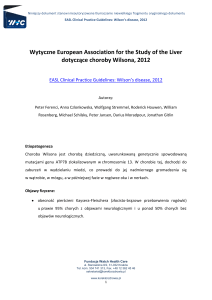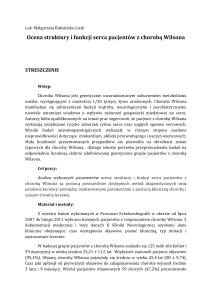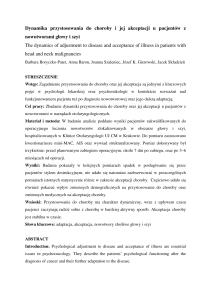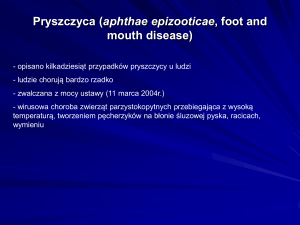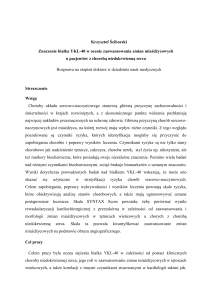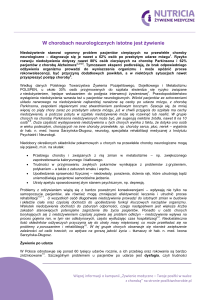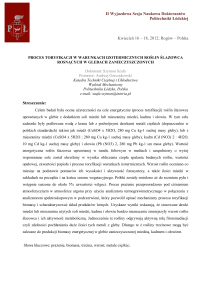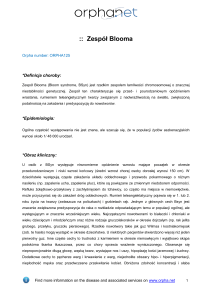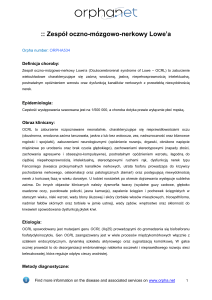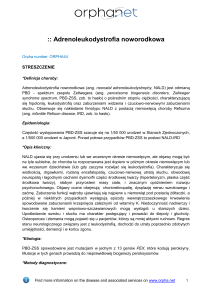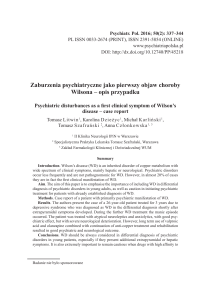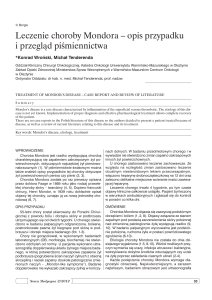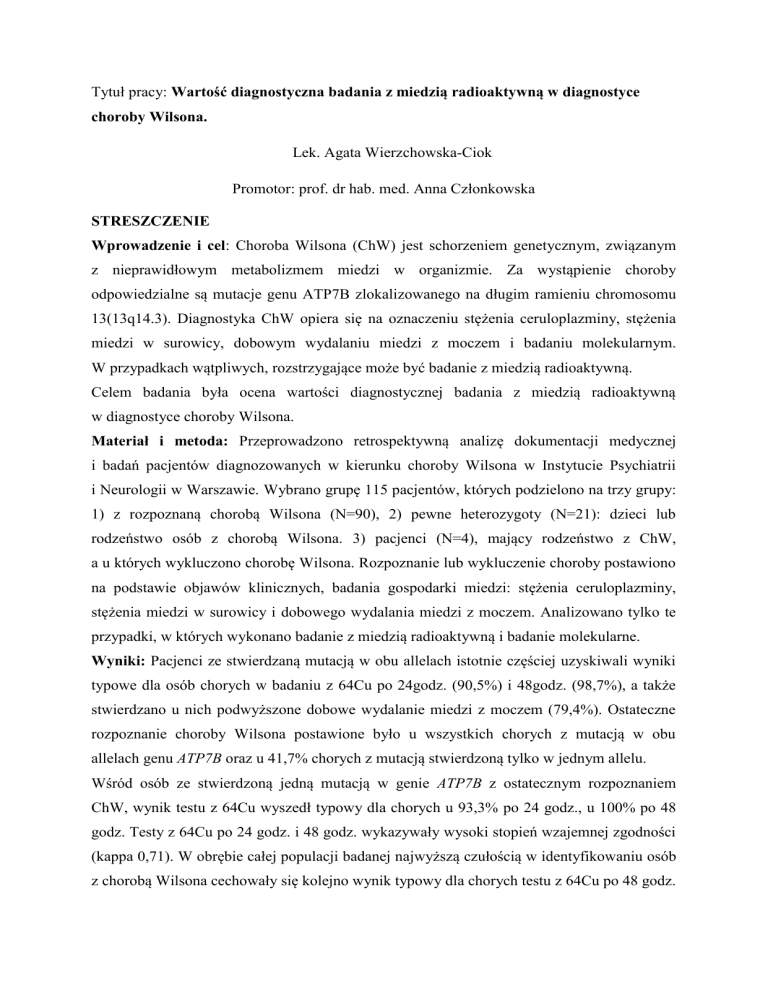
Tytuł pracy: Wartość diagnostyczna badania z miedzią radioaktywną w diagnostyce
choroby Wilsona.
Lek. Agata Wierzchowska-Ciok
Promotor: prof. dr hab. med. Anna Członkowska
STRESZCZENIE
Wprowadzenie i cel: Choroba Wilsona (ChW) jest schorzeniem genetycznym, związanym
z nieprawidłowym metabolizmem miedzi w organizmie. Za wystąpienie choroby
odpowiedzialne są mutacje genu ATP7B zlokalizowanego na długim ramieniu chromosomu
13(13q14.3). Diagnostyka ChW opiera się na oznaczeniu stężenia ceruloplazminy, stężenia
miedzi w surowicy, dobowym wydalaniu miedzi z moczem i badaniu molekularnym.
W przypadkach wątpliwych, rozstrzygające może być badanie z miedzią radioaktywną.
Celem badania była ocena wartości diagnostycznej badania z miedzią radioaktywną
w diagnostyce choroby Wilsona.
Materiał i metoda: Przeprowadzono retrospektywną analizę dokumentacji medycznej
i badań pacjentów diagnozowanych w kierunku choroby Wilsona w Instytucie Psychiatrii
i Neurologii w Warszawie. Wybrano grupę 115 pacjentów, których podzielono na trzy grupy:
1) z rozpoznaną chorobą Wilsona (N=90), 2) pewne heterozygoty (N=21): dzieci lub
rodzeństwo osób z chorobą Wilsona. 3) pacjenci (N=4), mający rodzeństwo z ChW,
a u których wykluczono chorobę Wilsona. Rozpoznanie lub wykluczenie choroby postawiono
na podstawie objawów klinicznych, badania gospodarki miedzi: stężenia ceruloplazminy,
stężenia miedzi w surowicy i dobowego wydalania miedzi z moczem. Analizowano tylko te
przypadki, w których wykonano badanie z miedzią radioaktywną i badanie molekularne.
Wyniki: Pacjenci ze stwierdzaną mutacją w obu allelach istotnie częściej uzyskiwali wyniki
typowe dla osób chorych w badaniu z 64Cu po 24godz. (90,5%) i 48godz. (98,7%), a także
stwierdzano u nich podwyższone dobowe wydalanie miedzi z moczem (79,4%). Ostateczne
rozpoznanie choroby Wilsona postawione było u wszystkich chorych z mutacją w obu
allelach genu ATP7B oraz u 41,7% chorych z mutacją stwierdzoną tylko w jednym allelu.
Wśród osób ze stwierdzoną jedną mutacją w genie ATP7B z ostatecznym rozpoznaniem
ChW, wynik testu z 64Cu wyszedł typowy dla chorych u 93,3% po 24 godz., u 100% po 48
godz. Testy z 64Cu po 24 godz. i 48 godz. wykazywały wysoki stopień wzajemnej zgodności
(kappa 0,71). W obrębie całej populacji badanej najwyższą czułością w identyfikowaniu osób
z chorobą Wilsona cechowały się kolejno wynik typowy dla chorych testu z 64Cu po 48 godz.
(0,99), obniżone stężenie ceruloplazminy (0,94) i wynik typowy dla chorych testu z 64Cu po
24 godz. (0,91). Pod względem swoistości na pierwszym miejscu plasowała się obecność
mutacji w obu allelach genu ATP7B (1,00), a następnie wynik testu z 64Cu po 48 godz.
typowy dla chorych (0,96) i podwyższone dobowe wydalanie miedzi z moczem (0,96).
Wnioski: Diagnostyka choroby Wilsona musi zawierać zarówno ocenę metabolizmu miedzi
jak i badanie molekularne. W przypadkach wątpliwych badanie z miedzią radioaktywną ma
znaczenie rozstrzygające. Przydatne jest zwłaszcza w przypadkach nietypowych: przy
niejednoznacznych wynikach gospodarki miedzi, stwierdzeniu obecności jednej lub braku
mutacji w genie ATP7B. Jednakże badanie z miedzią radioaktywną nie może być jedynym
badaniem w diagnostyce choroby Wilsona, musi być traktowane, jako badanie uzupełniające.
Ten projekt został współfinansowany ze środków Unii Europejskiej w ramach Europejskiego
Funduszu Społecznego.
STRESZCZENIE W JĘZYKU ANGIELSKIM
The diagnostic value of examination with radioactive copper in Wilson’s disease.
Introduction: Wilson’s disease (WD) is a genetic illness associated with the abnormal
metabolism of copper in the organism. The disease is caused by mutations of the ATP7B gene
located on the long arm of chromosome 13(13q14.3). Diagnosis of Wilson’s disease is based
on the examination of ceruloplasmin concentration, serum copper concentration, daily urinary
copper excretion and molecular genetic testing. In doubtful cases examination with
radioactive copper can be conclusive.
The purpose of the study was evaluation of the diagnostic value of examination with
radioactive copper in the diagnosis of Wilson’s disease.
Material and method: The retrospective analysis was carried of medical documentation and
the results of additional findings of patients diagnosed with Wilson’s disease in the Institute
of the Psychiatry and Neurology in Warsaw. A group of 115 patients was chosen, in which
patients were divided into three subgroups: 1) with diagnosed Wilson’s disease (N=90), 2)
certain heterozygotes (N=21)- children or the siblings of patients with Wilson’s disease,
3) patients (N=4) having the siblings with Wilson’s disease, in whom Wilson’s disease was
excluded. Recognition or exclusion of the disease was determined on the basis of clinical
symptoms, examination of copper management- ceruloplasmin concentration, serum copper
concentration and daily urinary copper excretion. The analysis included only these cases, in
which examinations with radioactive copper and molecular genetic testing were performed.
Results: Patients with confirmed mutation in both alleles, more often showed typical results
for ill people, while examining with 64Cu after 24 hours (90,5%) and 48 hours (98,7%). In
these patients the increased (79,4%) concentration of copper in 24-hour urine collection test
was found. Wilson’s disease was finally diagnosed in all patients with the mutation in both
alleles of the ATP7B gene and in 41.7% of ill patients with known mutation in only one allele.
Among patients with known single mutation in the ATP7B gene and final diagnosis of
Wilson’s disease, the test result with 64Cu appeared to be typical for ill patients in 93.3%
after 24 hours and 100% after 48 hours. Examination with 64Cu after 24 hours and 48 hours
showed a high degree of the cross-compliance (the kappa 0.71). Within the overall
investigated population, typical results for ill people of the test with 64Cu after 48 hours
(0,99), decreased ceruloplasmin concentration (0,94) and typical result for ill people with
64Cu test after 24 hours (0,91) respectively had the highest sensitivity in the identification of
patients with Wilson’s disease. In terms of specificity, mutation in both alleles of the ATP7B
gene was the first (1,00), followed by typical results for ill people of 64Cu test after 48 hours
(0,96) and the increased daily urinary copper excretion (0,96).
Conclusion: Wilson’s disease diagnosis must include both evaluation of copper metabolism
and molecular genetic testing. In doubtful cases, the examination with radioactive copper can
be conclusive. It is especially useful in atypical cases: in case of ambiguous results of copper
management, in the presence of one or lack of mutation in the ATP7B gene. However, the test
with radioactive copper cannot be an only examination in the diagnosis of Wilson’s disease, it
must be considered as a complementary test.
This project has been made with the support of the European Union funds by the European
Social Fund.

